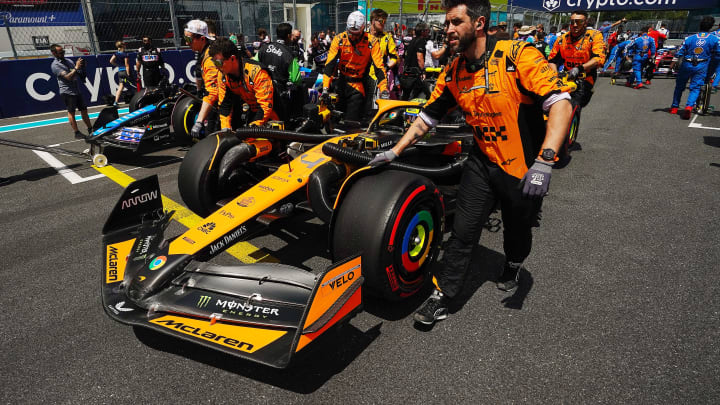Dutch Grand Prix 2024 Car Upgrades Revealed - McLaren Most Aggressive

As the Formula 1 season roars into its latter stages after the Summer break, teams are making a surge in upgrades to their cars in hopes of securing vital points and podium finishes. The 2024 Dutch Grand Prix, held at the iconic Zandvoort Circuit, is no exception, with several teams bringing significant updates to their cars.
Oracle Red Bull Racing: Cooling and Flow Conditioning Improvements
Red Bull, the dominant force of the season despite not necessarily being the fastest car on the grid right now, has introduced a series of updates aimed at optimizing their car's cooling and aerodynamic efficiency. The key changes include:
- Coke/Engine Cover: The engine cover has been narrowed to reduce blockage, catering to the cooling needs of upcoming races. This adjustment allows for a more streamlined airflow, which is crucial for maintaining optimal engine temperatures.
- Halo: The rearward fairing of the Halo has been revised to better align with the local flow conditions, improving the total pressure downstream over the floor's upper surfaces.
- Mirror Stays: Both the height and angle of the mirror stays have been modified. This change aims to enhance the flow conditions along the sidepods, contributing to better aerodynamic performance.
Mercedes-AMG Petronas F1 Team and Scuderia Ferrari: Playing It Safe
Both Ferrari and Mercedes have opted not to bring upgrades this weekend.
McLaren Formula 1 Team: Comprehensive Aerodynamic Overhaul
McLaren continues its aggressive development push with a host of upgrades aimed at enhancing aerodynamic efficiency and downforce:
- Front Brake Scoop: A new front brake scoop design improves overall flow conditions downstream, increasing aerodynamic load without compromising brake cooling.
- Front Suspension: Modified to complement the new front brake scoop, the front suspension has been adjusted to optimize the altered flow conditions.
- Floor Edge: A revised floor edge boosts local load generation and improves overall floor performance, critical for maintaining aerodynamic stability.
- Rear Suspension: Similar to the front, the rear suspension has been modified to enhance flow conditioning around the rear corner, diffuser, and beam wing area.
- Rear Wing and Beam Wing: A completely new high-downforce rear wing assembly has been introduced, paired with a matching beam wing, both tailored to the specific demands of the Zandvoort circuit.
Aston Martin Aramco F1 Team: Holding Steady
Like Mercedes and Ferrari, Aston Martin has chosen not to introduce any new components for this race. They're likely still aiming to maximize their recent upgrades.
BWT Alpine F1 Team: Targeted Aero Enhancements
BWT Alpine F1 Team has brought focused aerodynamic updates aimed at improving flow conditioning and local load:
- Front Suspension: The reprofiled front suspension leg offers better flow control, leading to improved aero performance towards the rear of the car.
- Rear Brake Duct Furniture: The rear brake duct furniture has been updated with a new winglets arrangement, optimizing the trade-off between downforce and drag.
These updates should help Alpine in balancing the car's aerodynamic performance, particularly in Zandvoort's challenging mid-to-high-speed corners.
Williams Racing: A Major Aerodynamic Upgrade
Williams Racing has rolled out a significant update package, focusing heavily on the floor and sidepod areas:
- Floor Body: The floor geometry has been completely overhauled, with increased height at the forward floor and reprofiled edges, all aimed at enhancing local load and flow conditioning.
- Diffuser: The new diffuser design complements the changes at the front, optimizing the airflow to extract more performance from the rear.
- Sidepod Inlet and Coke/Engine Cover: The sidepod inlet and engine cover have been redesigned to improve loss management and unlock further performance gains from the car's overall aero package.
- Central Air Intake: The roll hoop geometry has been revised, reducing mass and optimizing aero surfaces to further complement the updates in the sidepod and engine cover.
Visa Cash App RB: Rear Corner Refinements
Visa Cash App RB has focused its updates on the rear corner of the car:
- Rear Corner: The brake duct and winglet geometry have been updated, allowing for reduced brake cooling requirements and the addition of downforce-generating devices.
Stake F1 Team KICK Sauber: No Updates
The Stake F1 Team KICK Sauber has also decided not to bring any updates to the Dutch Grand Prix.
MoneyGram Haas F1 Team: Front-End Aerodynamic Adjustments
The Haas team has made several changes to the front end of their car:
- Front Wing: The new camber distribution on the front wing favors a cleaner flow along the nose and chassis, with the load now concentrated more at the mid-span.
- Nose: The nose has been extended to cover the first element of the front wing, aiming for a more efficient central flow that delivers higher energy to the floor and bodywork.
- Front Suspension and Corner: Both have been reprofiled and re-aligned to match the new front wing and nose design, ensuring that the incoming flow is managed more effectively.
